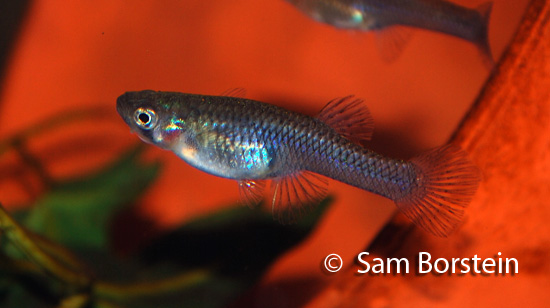Gambusia holbrooki
Girard, 1859
Eastern Mosquitofish
Synonyms:Gambusia affinis holbrooki

Above: a female Gambusia holbrooki. Photo by Sam Borstein.
Etymology:
Genus- Gambusia= From Cuban word Gambusino, translating to mean nothing (Spanish).
Species- holbrooki= Named after J. E. Holbrook.
Intro:
The Eastern Mosquitofish is a very interesting fish. This livebearer, first described by Girard in 1859 is very active and a bit nippy. This fish is very similar to the Western Mosquitofish, Gambusia affinis.Many Gambusia species are used as a form of mosquito control. Gambusia holbrooki and the similar Gambusia affinis are some of the more popular species stocked into ponds for this purpose.
Gambusia holbrooki is known to throw OB males.
This species is of concern due to its invasiveness. It depletes mosquito populations, therefore causing native species to struggle. On the other hand, it reduces diseases like malaria.
This fish is very tolerant of water conditions, adding to the problem of its invasiveness. I brought mine back from Sanibel Island, Florida in brackish water. On another trip to a different location on the island, I found them in 95 degree pool in almost pure saltwater.
Distribution:
Gambusia holbrooki is found in brackish and freshwater bodies of water. They are very temperature tolerant. This fish is found on Atlantic coastal states, and on the gulf coast of Florida.
Size, Maturity, and Sexual Dimorphism:
Size: Males- 1.5 inches, Females- 2.5 inchesMaturity: 1 inch
Sexual Dimorphism: Males are smaller than females and less rotund. Males have a gonopodium.
Care:
Eastern Mosquitofish are easy to care for. They are not demanding fish. A group of 15 can easily be kept in a 10. They can be kept without a heater in the tank. They can be mixed with other small and docile fishes in a larger community set up.
Diet:
As its common name suggests, the Mosquito fish eats insects and their larvae, like mosquitoes. These fish will eat anything under aquarium conditions. A mix flake is recommended.
Breeding:
This fish is very easy to breed. It's such an easy fish to spawn many propagate it as a live food. Males use their gonopodium to fertilize the females. Females will swell up with the babies inside them, and after about 3 weeks, give birth.
The fry do have umbilical cords, but lose them after birth. Fry grow fast and by three weeks are sexually mature!
Conclusion:
Eastern Mosquitofish are cool livebearers. Personally I like them a lot. I think they are neat and any livebearer fan should try them once. They are usually easy to obtain from the wild but are not always in the hobby and are seldom seen in pet shops.
References:
- Miller, R.R., Minckley, W.L. & Norris, S.M. (2005) Freshwater Fishes of México. Museum of Zoology, University of Michigan, & University of Chicago Press, Chicago, 652 pp.
